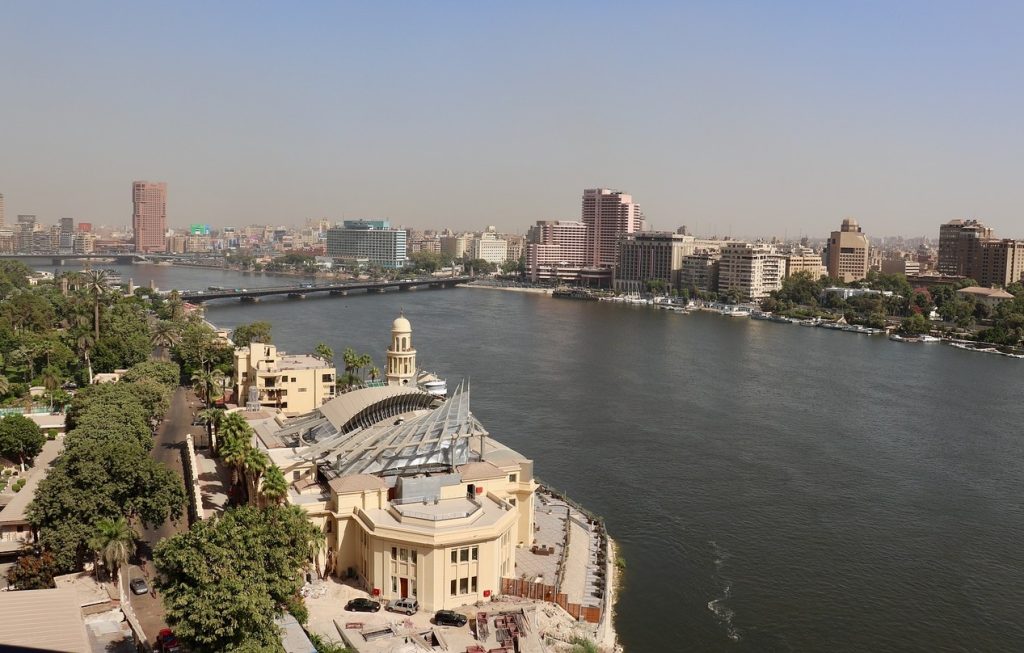Egypt, often called the cradle of civilization, is a land steeped in ancient history and mystery. Located in Northeastern Africa and sharing a border with the Middle East, this country boasts a remarkable heritage that dates back thousands of years. The Nile River, the longest river in the world, has been the lifeblood of Egypt, nurturing its fertile lands and fostering a civilization that thrived on its banks.
One of Egypt’s most iconic symbols is the Great Pyramids of Giza, a testament to the ancient Egyptians’ advanced architectural and engineering prowess. These pyramids, along with other historic sites like the Sphinx and the Valley of the Kings, attract millions of visitors each year, captivated by the mysteries of the pharaohs and their extraordinary achievements.
Egypt is also revered for its rich culture and traditions. From its unique cuisine, known for its aromatic flavors and diverse dishes, to its captivating music and dance forms, including the famous belly dance, Egypt’s cultural heritage is deeply ingrained in its society. The Egyptian Museum in Cairo is a treasure trove of artifacts and relics, offering a glimpse into the country’s historical narrative.
In contemporary times, Egypt stands as a vibrant nation with a blend of modernity and tradition. Its capital, Cairo, is a bustling metropolis with a pulsating energy, juxtaposing skyscrapers and shopping malls with historic neighborhoods and bustling markets. Egypt’s warm hospitality and the genuine friendliness of its people add an inviting layer to the rich tapestry of experiences this country has to offer.
As Egypt moves forward, it grapples with the challenges of balancing its ancient heritage with the demands of a rapidly evolving society. It’s a place where the past whispers to the present, reminding the world of the enduring legacy of one of the world’s most ancient civilizations.

Pyramids
What about Egypt interesting facts? Here are 65 interesting facts about Egypt.
- Pyramids: Egypt is home to the Great Pyramid of Giza, one of the Seven Wonders of the Ancient World.
- Nile River: The Nile River, the longest river in the world, flows through Egypt.
- Hieroglyphics: Ancient Egyptians used hieroglyphics, a system of pictorial writing, for communication.
- Sphinx: The Great Sphinx of Giza is a colossal limestone statue with the body of a lion and the head of a Pharaoh.
- King Tutankhamun: Tutankhamun, often referred to as King Tut, was an Egyptian Pharaoh who ascended the throne at a young age.
- Cleopatra: Cleopatra VII, the last Pharaoh of Egypt, was known for her beauty and intelligence.
- Papyrus: Ancient Egyptians made paper-like material called papyrus from a plant of the same name.
- Luxor: Luxor hosts a vast complex of temples and tombs on the east and west banks of the Nile.
- Aswan High Dam: The Aswan High Dam was built to control the flooding of the Nile and generate electricity.
- Karnak Temple: The Karnak Temple complex in Luxor is one of the largest religious buildings ever constructed.
- Suez Canal: Egypt’s Suez Canal is a vital waterway connecting the Mediterranean Sea to the Red Sea.
- Alexandria: Alexandria, a city founded by Alexander the Great, was one of the most significant cities in the ancient world.
- Desert: Egypt is mostly desert, with the Sahara covering much of its land area.
- Cats: Cats were highly revered in ancient Egypt and were often kept as pets to ward off evil spirits.
- Eye Makeup: Both men and women in ancient Egypt wore heavy eye makeup, believed to have medicinal and spiritual benefits.
- Camels: Camels are commonly associated with Egypt and are often referred to as the “ships of the desert.”
- Coptic Christianity: Egypt is home to one of the oldest Christian communities in the world, known as Coptic Christians.
- Pharaohs: The title of Pharaoh was used to refer to the kings of ancient Egypt.
- Lotus Flower: The lotus flower is a symbol of rebirth in ancient Egyptian mythology.
- Ankh: The ankh is an ancient Egyptian symbol representing life and immortality.
- Rosetta Stone: The Rosetta Stone played a crucial role in deciphering hieroglyphics.
- Oasis: Egypt has numerous oases, providing habitable areas within the desert.
- Population: Egypt is the most populous country in the Arab world and the third most populous in Africa.
- Arabic: Modern Egyptian Arabic is the most widely spoken and understood language in the country.
- Islamic Architecture: Islamic architecture, with its stunning mosques and minarets, is prominent in Egypt.
- Felucca: Feluccas are traditional wooden sailing boats commonly seen on the Nile River.
- Alexandrian Library: The ancient Library of Alexandria was one of the most significant libraries of the ancient world.
- Sun Temples: Ancient Egyptians worshiped the sun and built temples like Abu Simbel to honor the sun god, Ra.
- Nubian Village: Some parts of southern Egypt are home to Nubian communities with a unique culture and language.
- Omar Sharif: The famous actor Omar Sharif was born in Egypt and gained international fame.
- Oil Reserves: Egypt has significant reserves of petroleum and natural gas.
- Siwa Oasis: Siwa Oasis is known for its stunning landscapes and ancient Oracle Temple of Amun.
- Aswan: Aswan is famous for its High Dam, the Unfinished Obelisk, and the Temple of Philae.
- White Desert: The White Desert is a unique landscape of white limestone formations in Egypt’s Western Desert.
- Red Sea: Egypt has a vibrant underwater world in the Red Sea, making it a popular diving destination.
- Tahrir Square: Tahrir Square in Cairo has been a significant site for protests and historic events.
- Muhammad Ali Pasha: He is regarded as the founder of modern Egypt and ruled as a semi-autonomous governor under the Ottoman Empire.
- Egyptian Pound: The official currency of Egypt is the Egyptian pound (EGP).
- Cairo Tower: The Cairo Tower is one of the city’s landmarks, offering panoramic views of Cairo.
- Bazaar Shopping: The Khan el-Khalili market in Cairo is a bustling bazaar where you can find traditional Egyptian items.
- Koshary: Koshary is a popular Egyptian street food made with rice, lentils, macaroni, and spicy tomato sauce.
- Sphinx Avenue: The Avenue of the Sphinxes once linked the temples of Luxor and Karnak.
- Muizz Street: Al-Muizz Street is a historical street in Cairo, showcasing stunning medieval Islamic architecture.
- Egyptian Museum: The Egyptian Museum in Cairo houses an extensive collection of ancient artifacts.
- Mahshi: Mahshi is a traditional Egyptian dish made by stuffing vegetables like bell peppers and grape leaves.
- Egyptian Folk Music: Traditional Egyptian music includes instruments like the oud, darbuka, and ney flute.
- Horus: Horus, the falcon-headed god, was a significant deity in ancient Egyptian religion.
- Belly Dancing: Belly dancing, or Oriental dance, is a popular traditional dance in Egypt.
- Luxor Obelisks: Luxor is home to a pair of massive obelisks, one of which is now in Paris, known as the Luxor Obelisk.
- Book of the Dead: The Book of the Dead is a collection of spells and illustrations guiding the deceased through the afterlife.
- Isis: Isis was a powerful and revered goddess in ancient Egyptian mythology.
- Aswan Botanical Garden: The Aswan Botanical Garden is a beautiful island garden on the Nile.
- Lotus Temple: The Lotus Temple, or the Baha’i House of Worship, is an architectural marvel in Cairo.
- Port Said: Port Said, located at the northern entrance of the Suez Canal, is a vital Egyptian port city.
- Valley of the Queens: The Valley of the Queens is where many wives of pharaohs were laid to rest.
- Egyptian Mau: The Egyptian Mau is a distinctive breed of domestic cat known for its spotted coat and grace.
- Cairo Citadel: The Saladin Citadel of Cairo offers breathtaking views of the city and houses several museums and mosques.
- Sahara Marathon: The Sahara Marathon is an annual marathon held in the Saharan refugee camps in Algeria.
- Shaduf: The shaduf is an ancient Egyptian irrigation tool used to lift water from the Nile for farming.
- City of the Dead: The City of the Dead in Cairo is a vast cemetery where people live and work among the tombs.
- Siwa Shali: Siwa Shali is an ancient mud-brick fortress in the Siwa Oasis, displaying Siwan architecture.
- Cleopatra’s Needle: London, Paris, and New York each have an ancient Egyptian obelisk known as Cleopatra’s Needle.
- Necropolis: The Valley of the Kings, a famous necropolis, is where many pharaohs and nobles were buried.
- Tutankhamun’s Curse: The belief in the curse of Tutankhamun’s tomb bringing misfortune to those who disturb it gained global attention.
- Blue Hole: The Blue Hole in the Red Sea, near Dahab, is a renowned diving spot but also known for its high number of diving accidents.

Nile River
Egypt, a land of ancient mysteries and timeless beauty, holds a unique place in the tapestry of human civilization. Its colossal pyramids, enigmatic Sphinx, and temples that echo tales of powerful pharaohs evoke awe and wonder. The country’s rich cultural heritage, spanning millennia, weaves tales of triumph, struggle, and the enduring human spirit. As the Nile River serenely flows through this land, nourishing both the land and its people, it symbolizes the resilience and adaptability of the Egyptian society across centuries. The bustling markets, aromatic cuisine, and the warmth of its people provide a vibrant and welcoming experience, allowing visitors to immerse themselves in this ancient yet ever-evolving society.
Beyond its iconic landmarks, Egypt boasts a profound connection to the very essence of human history. It’s a place where the sands of time whisper tales of the past, and every stone holds the weight of thousands of years. The juxtaposition of modernity and antiquity is a testament to Egypt’s ability to honor its past while moving forward. From the banks of the Nile to the bustling streets of Cairo, Egypt invites explorers to delve into its ancient mysteries and experience the timeless allure that continues to beckon visitors from across the globe. In the heart of Egypt, beneath the golden sun and amidst the whispers of the ancients, one can find not just history but a living story, an invitation to understand and celebrate the remarkable journey of humankind.





